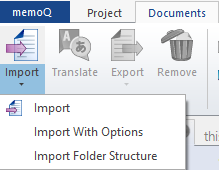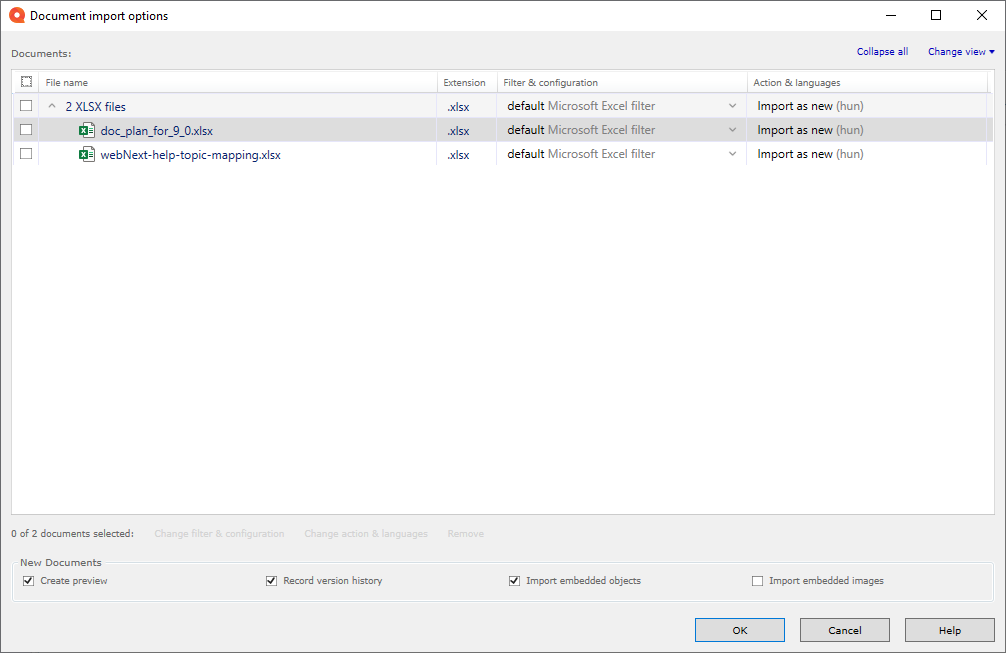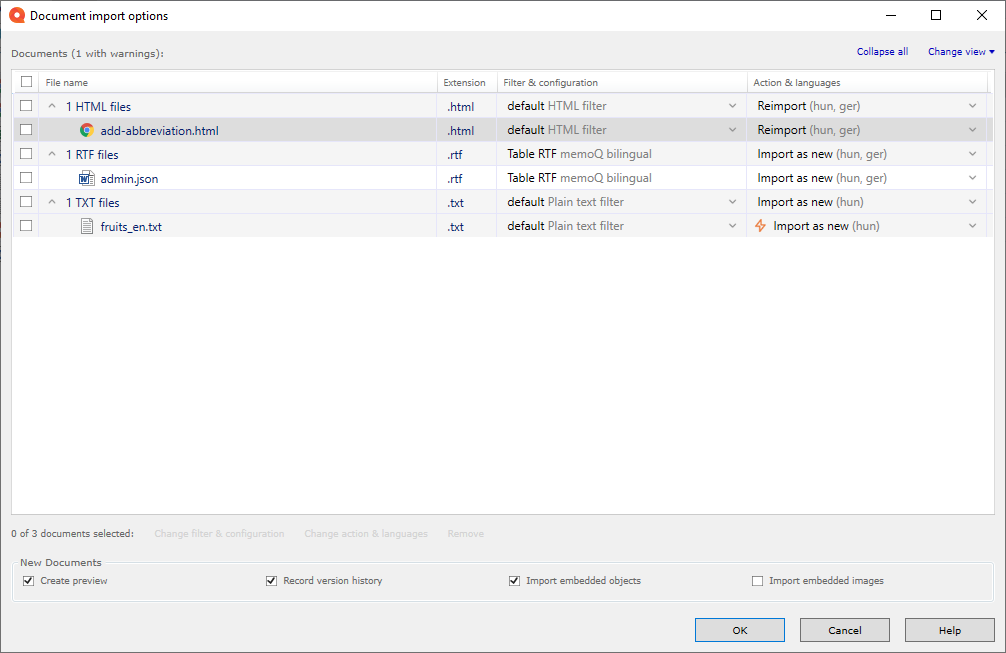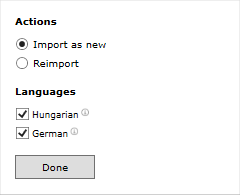Document import options
To add documents to a project, you can simply throw documents at it. Then memoQ imports them with the default settings, which don't always produce the results you expect. For some document types (such as plain text or XML), the default settings don't even make sense most of the time.
To import a document, memoQ must know how to do it. For that, it needs a filter configuration. A filter configuration tells memoQ how to read - import - a document that needs to be translated. When memoQ imports a document, it gets the text out of it, and stores the formatting (and everything else that doesn't need to be translated) in a safe place. The part that is not the text is called a skeleton.
When you need to import documents with customized settings, use the Import with options command. That's when you get the Document import options dialog.
Here are a some reasons to use Import with options rather than just importing the documents:
- There's a specialized filter configuration for the documents you are importing.
- You want to set up a specialized filter configuration for the documents.
- You want to check and control the update of bilingual documents in your project.
- You want to import the embedded images from a document.
- You want memoQ to import the documents without the preview.
How to get here
- Open a local project. In Project home, choose Translations.
- In the Documents ribbon, click the down arrow below the Import icon.

- From the menu, choose Import with options.
- An Open window appears. Find and select the documents you want to import. Click the Open button.
- The Document import options window appears.
Or:
- Open a local project. In Project home, choose Translations.
- In the Documents ribbon, click the down arrow below the Import icon.

- From the menu, choose Import Folder Structure.
- The Add Folder Structure window appears. Choose the folder you want to import. Check if all files you need are there. Set an export path. Click OK.
- The Document import options window appears.
Or:
- Open an online project for management. In the memoQ online project window, choose Translations.
Choose languages: Normally, memoQ imports the new documents for all target languages. To import the documents for just one target language, choose the language at the top right.
- Right-click anywhere in the Translations list.
- From the menu, choose Import with options.
Or, import a folder: From the menu, choose Import Folder Structure. The Add Folder Structure window appears. Choose the folder you want to import. Check if all files you need are there. Set an export path. Click OK.
- An Open window appears. Find and select the documents you want to import. Click Open.
- The Document import options window appears.
Or:
- Open a project. In Project home, choose Translations.
Or: Open an online project for management. In the memoQ online project window, choose Translations.
- Select the documents you want to reimport.
- Right-click the selection. From the menu, choose Reimport.
If the source documents are still there where they were first imported from: memoQ offers to import them again. If you don't choose this: An Open window appears. Find the new versions of the documents. Select them. Click Open.
- The Document import options window appears.
Reimport always happens with options: When you reimport a document, memoQ assumes that you're not satisfied with the results of the first import. You get the Document import options window automatically, so that you can make the changes you need.

Document import options in a bilingual project

Document import options in a multilingual project
What can you do?
Normally, memoQ groups the imported files by their types, and shows the groups expanded.
To change or turn off grouping: In the top right corner, click the Change view link. Choose the File type or the No grouping (flat view) option, and click the Close button.
To collapse or expand a group: Click the up or down arrow on the left side of the group header row. OR: Double-click the group header row.
To collapse or expand all groups: In the top right corner, click the Collapse all or Expand all link.
To show or hide the full path of documents: In the top right corner, click the Change view link. Check or clear the Show full path check box, and click the Close button.
To show or hide documents which will be imported without problems: In the top right corner, click the Change view link. Check or clear the Show errors and warnings only check box, and click the Close button.
To remove one or more files from the list: Check their check boxes. (OR: Hold down the Ctrl key, and click their rows.) Under the list, click the Remove link.
To change the filter or the configuration for a single document:
- Click the Filter & configuration dropdown.
- Start typing the name of the configuration you need.
- Click the configuration.
To change the filter or the configuration for two or more documents:
- In the list of documents: Click the row of the first document you need to import with a different configuration. Hold down the Ctrl key, and click all the other documents you need to select. OR: Check their check boxes.
Careful with document types: Make sure you select documents of the same type. Check if the selected documents really need to be imported with the same configuration.
If all the documents are the same type: Check the check box in the top left corner of the list.
- At the bottom, click Change filter & configuration.
- The Document import settings window appears.

memoQ recognizes the document format from the extension of the file. Still, you may want to use a different filter configuration.
The extension isn't everything: In some cases, it can be misleading. For example, plain-text files often have an extension that's not TXT, and many XML files are called something different from .XML. But sometimes even a .HTML or an .XLIFF file needs to be imported as plain XML.
When memoQ can't choose: Some extensions are unfamiliar for memoQ. In the Document import options window, these files will be marked by an orange lightning bolt ![]() (a warning sign). You must choose a filter configuration manually for these documents. In this case, choose the filter and the configuration from the drop-down boxes in the list itself.
(a warning sign). You must choose a filter configuration manually for these documents. In this case, choose the filter and the configuration from the drop-down boxes in the list itself.
- From the Filter dropdown: Choose a different filter if you really need to.
- From the Filter configuration dropdown: Choose the filter configuration you need.
The filter configuration needs to be available on your computer.
For online projects: The filter configuration must be available either locally on the computer itself, or on a server that you're connected to. (This is usually a server where you're importing documents into an online project.)
To set up a filter configuration: Adjust the settings in the Document import settings window, and save the configuration. (To do that, see the next section on this page.) Or, if you have the filter configuration in a file: Open Resource console. Choose Filter configurations. Import the filter configuration.
- Click OK.
To learn more: See the topic for the Document import settings window.
- In the list of documents: Click the row of the first document you need to import with a different configuration. Hold down the Ctrl key, and click all the other documents you need to select. OR: Check their check boxes.
Careful with document types: Make sure you select documents of the same type. Check if the selected documents really need to be imported with the same configuration.
If all the documents are the same type: Check the check box in the top left corner of the list.
- At the bottom, click Change filter & configuration.
- The Document import settings window appears.

memoQ recognizes the document format from the extension of the file. Still, you may want to use a different filter configuration.
The extension isn't everything: In some cases, it can be misleading. For example, plain-text files often have an extension that's not TXT, and many XML files are called something different from .XML. But sometimes even a .HTML or an .XLIFF file needs to be imported as plain XML.
- From the Filter dropdown: Choose a different filter configuration if you really need to.
- Don't touch the Filter configuration dropdown.
Instead, choose the settings in the main part of the Document import settings window. The settings are different for each document type.
- To save the configuration: Next to the Filter configuration dropdown, click the Save new
 icon.
icon. - The Create new filter configuration window appears. Type a name and a description for the filter configuration, and click OK.
- Click OK.
To learn more: See the topic for the Document import settings window.
To have your documents reviewed: You can export bilingual documents; send them to a reviewer; receive the reviewed bilingual documents from the reviewer; and import them back in the project. When this happens, memoQ will update the documents.
This is all automatic: memoQ recognizes if a bilingual document is an update to an existing document in the project. Then the document is updated. The Change filter & configuration and Change action & languages commands are grayed out.
If you update several documents from bilingual files:
- Import the bilingual files with the Import with options command.
- The list will show if a file can't be used to update a document: In the row of the document, the Action & languages column will say Import as new.
When a document can't be updated: Import the bilingual document as a new one. (You don't have a choice.) Use the Confirm and update rows command to update the working translation memory. Return to the original document. Update its contents: pre-translate with the translation memory.
This works with XLIFF files and table RTF documents.
To learn more: See the topic about exporting bilingual documents.
When you reimport a document, memoQ will create a new major version of the document in the project. To get the translations from the previous version, you need to X-Translate the document. The reimport will be accurate if memoQ uses the exact same settings as it used when the document was first imported.
memoQ will remember the filter that was used to import the document, and it will try to remember the configuration, too. However, sometimes that is not easy. To choose the same configuration as before: In the Filter & configuration dropdown, choose the configuration marked as (used last time).
To reimport one or more documents:
- Start importing the documents with options.
- In the Document import options window, the Action & languages column will say Import as new.
- Check the check boxes of the files you need to reimport. OR: Hold down the Ctrl key, and click their rows.
- At the bottom, click the Change action & languages link.
- Choose the Reimport option.
If you leave the Import as new option unchanged: memoQ imports another copy of the documents into the project.
For a single document: Instead of importing with options, you can also click the Reimport button.
From some documents - Microsoft Office documents, mostly -, memoQ can import embedded objects and embedded images, too. These can have text that needs to be translated.
To import the documents together with embedded objects and images:
- Start importing the documents with options.
- In the Document import options window, set up the filter and the configuration for every document.
- To import embedded images: At the bottom, check the Import embedded images check box.
- To import embedded objects (such as Excel sheets embedded in Word documents): At the bottom, check the Import embedded objects check box. (It's checked by default: clear it if you don't want the embedded objects.)
For more control over embedded objects in Office documents and ZIP files: Create a composite filter.
The preview works in the translation editor. It gives you a formatted (or structured) view of the document you are translating.
The preview isn't guaranteed: memoQ does everything to produce a preview for every document. But there are document formats where it's impossible to get a preview. In other cases, memoQ relies on external technology to create and show the preview. Sometimes this doesn't work, and memoQ doesn't have control over it.
You need this when memoQ can't create the preview because there's an error. Or, when memoQ simply takes too long to create the preview.
When this happens, you need to import the documents without the preview, so that you can import the documents at least.
To import the complete documents without the preview:
- Start importing the document with options.
- In the Document import options window, set up the filter and the filter configuration for every document.
- To turn off the preview: At the bottom, clear the Create preview check box.
Preview works for these document formats: Microsoft Word, Excel, PowerPoint, HTML, XML (through XSLT style sheets, too), multilingual Excel, text, WPML XLIFF, and XML, and - through Language Terminal - InDesign.
The PDF Preview tool may help: When memoQ cannot create a preview for a file type, but you have a reference PDF of the document, try the PDF Preview tool.
When you import documents into a multilingual project: You can choose the target languages for the documents. memoQ offers the documents for translation into those target languages you choose.
Normally, memoQ imports the documents for all target languages. Except when you choose target languages before importing the documents.
- Start importing the document with options.
- In the Document import options window: Check the check boxes of the documents where you want to change the target languages. OR: Hold down the Ctrl key, and click their rows.

- At the bottom, click Change action & languages. The Action & languages pane appears.

For a single document: You don't need to select the check box. Just click the Action & languages dropdown.
- Choose the target languages you need.
- To add a language: Check its check box.
- To remove a language: Clear its check box.
- To save your changes: Click the Done button. To discard your changes: Click outside the Action & languages pane.
In the row of the selected documents: The Languages column shows the languages you selected.
Don't clear the Record version history check box: memoQ keeps track of the history of each document. To do that, it stores extra information in the documents. You need this to view the documents with track changes, or to review changes that a reviewer made. If you switch this off, it saves some space on your computer. But on the whole, turning off version history isn't a good idea.
When you finish
To import, reimport, or update the documents with the settings you chose: Click OK. memoQ returns to the Translations pane. (Project managers click here.)
To return to the Translations pane, and not import the documents: Click Cancel. (Project managers click here.)